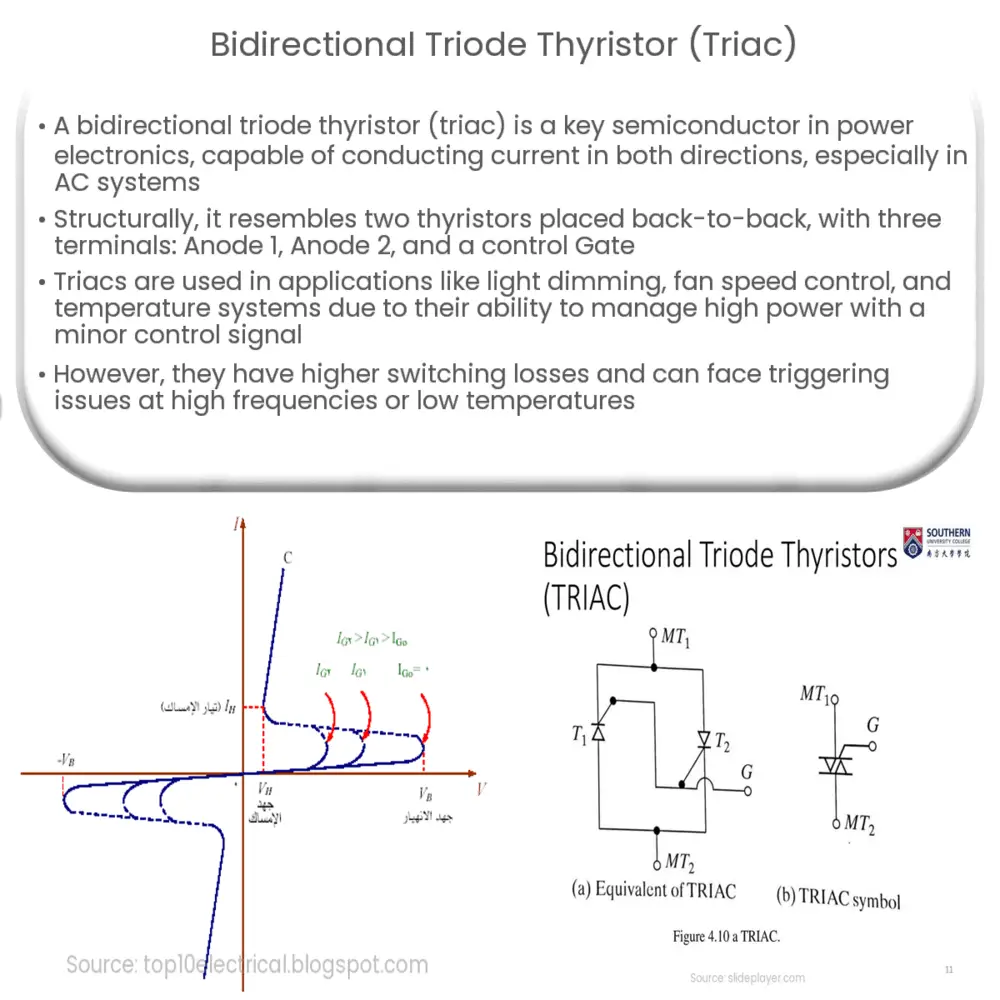Explore the bidirectional triode thyristor (triac), its structure, working principle, applications, advantages, and drawbacks in power electronics.

Introduction to Bidirectional Triode Thyristor (Triac)
A bidirectional triode thyristor, more commonly referred to as a triac, is a crucial semiconductor device in the realm of power electronics. Its ability to conduct current in both directions and its capability to control power make it a preferred choice for various applications, particularly in alternating current (AC) systems.
Structure of a Triac
The triac is essentially a three-layer, five-junction, four-terminal device. Two terminals, known as the Anode 1 (A1) and Anode 2 (A2), are used for power handling, while the third terminal, called the Gate (G), is used for control. The inner structure is akin to two thyristors placed back to back, providing the ability to conduct current in both directions, hence making it a bidirectional device.
Working Principle of a Triac
The working of a triac is divided into four distinct modes: two for forward biasing and two for reverse biasing. Its operation is closely related to its structure, with the current conduction happening through different layers depending on the gate voltage and the polarity of the applied voltage.
- First Quadrant Operation (MT2 and G are positive): In this mode, both MT2 and G are supplied with a positive voltage. This mode is also known as the forward blocking mode.
- Second Quadrant Operation (MT2 is positive, G is negative): MT2 is supplied with a positive voltage while the gate is supplied with a negative voltage. This is the forward conduction mode.
- Third Quadrant Operation (MT2 and G are negative): Both MT2 and G are supplied with negative voltage, making it the reverse blocking mode.
- Fourth Quadrant Operation (MT2 is negative, G is positive): MT2 is supplied with a negative voltage, while G is supplied with a positive voltage. This is the reverse conduction mode.
Applications of Triac
Due to its bidirectional conducting nature, the triac is widely used in various applications, primarily in AC power control systems. Some of the key applications include light dimming circuits, speed control in fans, temperature control systems, and more. Its ability to control high amounts of power with a small control signal makes it an efficient choice for these systems. The following section will delve deeper into each of these applications.
Detailed Applications of Triac
- Light Dimming Circuits: Triacs are popularly used in light dimming circuits. They can regulate the brightness of lamps by controlling the power delivered to the lamp. This is achieved by adjusting the phase angle of the AC wave.
- Speed Control in Fans: Much like their application in light dimming, triacs are also used in fan regulators to control the speed of fans. The voltage applied to the fan motor is varied by the triac, thereby adjusting the speed.
- Temperature Control Systems: Triacs find a significant role in temperature control systems such as thermostats, where they control the power supplied to the heating elements.
- Motor Control: Motor control circuits often use triacs to control the speed and direction of AC motors. They can efficiently handle the high power requirements of these motors.
Advantages and Disadvantages of Triac
The main advantage of a triac is its ability to control AC power for both positive and negative half cycles, with just a single device. Its relatively compact size, simplicity of operation, and wide range of controlling power make it an excellent choice for various applications.
However, triacs also have a few drawbacks. Their switching losses are higher compared to other power electronic devices. They are also susceptible to not triggering correctly when used at high frequencies or low temperatures. Understanding these limitations is crucial when considering their use in certain applications.
Conclusion
In conclusion, the bidirectional triode thyristor, or triac, is an essential component in power electronics, particularly in AC systems. Its bidirectional conducting ability, along with its power controlling capacity, make it an excellent choice for a wide array of applications like light dimming, speed control in fans, and temperature control systems. Despite a few limitations such as higher switching losses and potential triggering issues, its advantages far outweigh its drawbacks, making it a versatile and efficient device in the field of power electronics.

